Drew Barrymore's Sustainable Home Goods Collab Nods To the Rise of Refillables

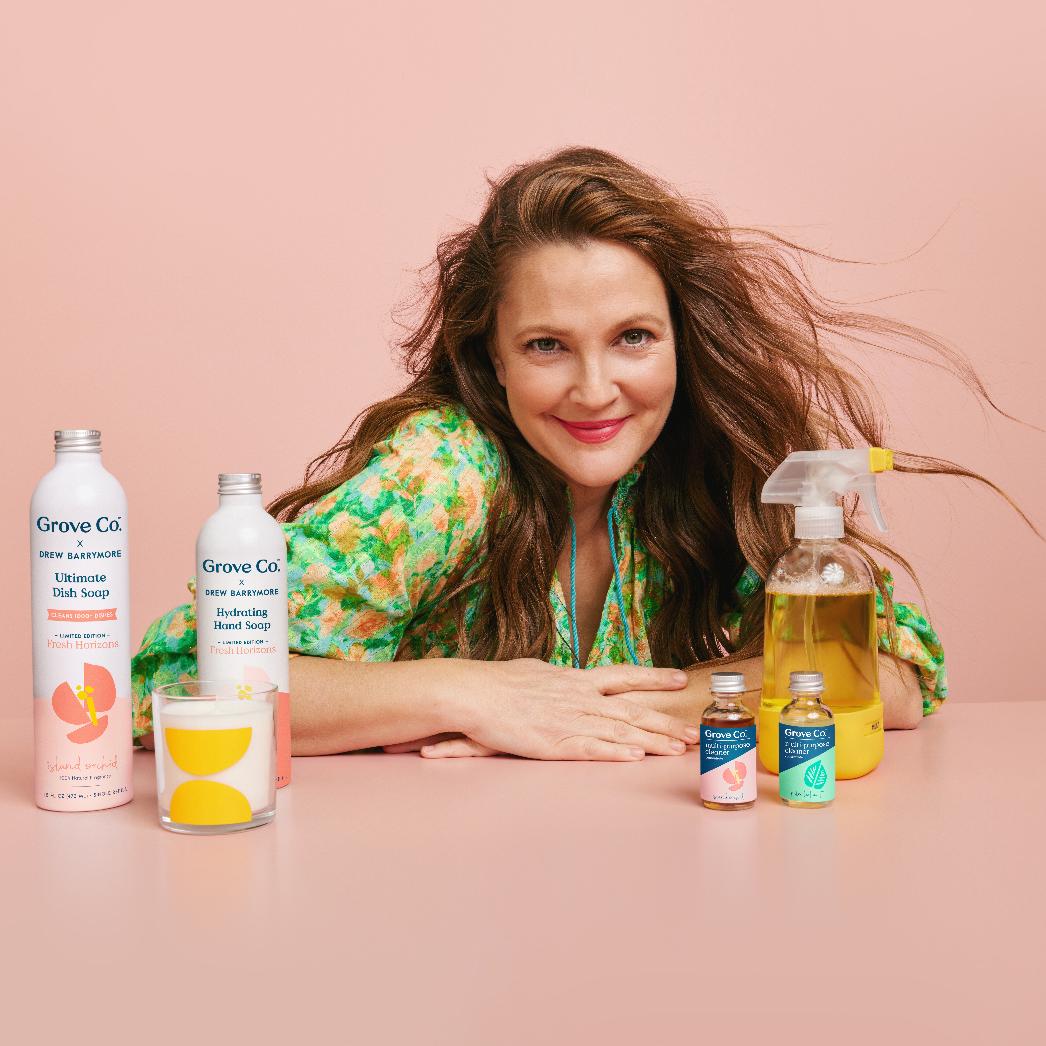
The effervescent Drew Barrymore has partnered with sustainable consumer brand Grove Collaborative on a line of 15 home goods products. The limited-edition collection features refillable packaging and two signature scents.
Consumers have signaled that they're ready for refillable and sustainable products, and there’s a blossoming potential to bring them to scale. Celebrity endorsements and partnerships like this one can help influence a growing number of consumers to take the leap toward eliminating excessive packaging and single-use items from their day-to-day lives.
Bright and bubbly like Drew Barrymore
“I am so excited to be launching my first sustainable collection of home care products with Grove Co.,” Drew Barrymore said in a statement. “I wanted to create a line of home accessories that were bright, modern and inspired by the beauty of the natural world. Every piece was designed and crafted to be sustainable, beautiful, and effective for the health of people and the planet. I hope the collection inspires others to take action and embark on their own sustainability journey — making it easier to use less plastic in their daily lives.”
The Fresh Horizons Limited Edition Collection includes refillable dispensers and a refillable glass spray bottle, as well as hand wash sheets, laundry detergent sheets, candles, and a dishcloth made from cotton and biodegradable cellulose. Dish soap, hand soap and multi-purpose cleaning concentrate are available as refills.
Beyond its eco credit, the collection features big pops of color and fun patterns that reflect the star’s bubbly personality and seemingly endless energy — not to mention two island-inspired, special-edition scents developed especially for the line.
There is zero single-use plastic involved in the line. More broadly, Grove Co. — which already opts for refillable packaging over single-use in many of the products it sells — has vowed to eliminate all plastics from products and packaging by 2025.
“Working closely with Drew to craft the concept and design of these products has been such a pleasure, and we have been able to create something beautiful and modern that is also rooted in sustainability," Lucy Leahy, general manager of Grove Co, said in a statement. "This collection combines colorful designs, high-quality materials and high-performing products that are better for people and the planet. We are so excited to bring Drew’s first co-created collection with Grove Co. to life."
Scaling up refillable and sustainable packaging
For now, refillable and sustainable products like these remain part of a niche market. But between their reasonable prices and celebrity partnerships with the likes of Drew and interior design guru Jeremiah Brent, Grove Co. has the potential to spearhead consumer interest and make converts out of the refill curious.
Indeed, a 2022 study by Trivium Packaging found that nearly 75 percent of consumers have an interest in refillable products, while 86 percent of those under the age of 44 are prepared to pay more for a product if its packaging is sustainable.
“The data ... presents a strong case that transitioning to sustainable packaging is not only the right decision for the environment, but also the right decision for any business,” Jenny Wassenaar, chief sustainability officer at Trivium Packaging, told Grit Daily of the findings. She described how metal packaging in particular is ideal for a circular economy, saying: “Once produced, metals exist forever and can be used, reused, and recycled endlessly without losing quality.”
A blast from the past
Single-use packaging is a relatively new thing, as McKinsey & Coo pointed out in its 2022 study on scaling up reusables. The near monopoly of disposable packaging is a product of very recent history. And although developing the systems to support reusable and refillable packaging may appear difficult, the industry is actually ripe for innovation. While single-use packaging has long been used as a method for advertising, brands could potentially build consumer loyalty by taking the initiative to change the way they package and be at the forefront of a reusable revolution.
Although single-use packaging is cheaper than reusable and refillable alternatives, changes to plastic regulations could play their own role in encouraging the switch. For example, the cost of single-use packaging could very well become prohibitive if the U.N. plastics treaty ends up including “polluter pays” language. Even further, the treaty could put the final nail in disposable packaging’s coffin — if single-use plastics are banned altogether.
As such, brands would do well to make leading the charge toward reusable and refillable packaging part of their purpose. And while innovation will be key, perhaps the most innovative concept can be gleaned from the past — as in standardized containers and home delivery.
The price range for Drew Barrymore's Fresh Horizons Limited Edition Collection starts at $5.49 and goes up to $14.99. The products are available online with Grove and Target and in designated Meijer and Target brick-and-mortar stores.
Image credit: Drew Barrymore and Grove Co. via Business Wire
The Necessity of Inner Work To Be An Effective Environmentalist


“Love and justice are not two. Without inner change, there can be no outer change; without collective change, no change matters.” — Rev. angel Kyodo williams
In the last part of this two-part article series, we examined how white culture and white privilege impact the ways in which we engage with communities around sustainability. As Rev. williams suggests, to solve the problems of separation, obsessive productivity and exploitation caused by white culture, we need to advance our “inner change work,” which impacts the “outer change work.”
Unlearning white conditioning is an ongoing process — like an intention rather than a goal, you’re never completely done. I’ll be the first to admit I’m still a work in progress here. But here are some ideas on how to get started.
Mindfulness meditation practice
The same mental process that helps you come back to the present moment when you’re working or feeling stressed can also be used to wake up from thoughts like “that person looks suspicious” when it’s just a person of color walking down the street. (“Suspicious” is a behavior, not a skin color, and sadly, deaths caused by police disproportionately affect people of color.)
You can’t change what you are not aware of, so the first step to making change happen in your own behavior is to be aware of your inner dialogue. Don’t believe everything you think. Mindfulness meditation practice helps with cultivating more focused attention and relaxed awareness so you can catch white supremacy culture thoughts before they turn into racist beliefs, comments or actions.
Loving-kindness and self-compassion: Appreciate the parts of yourself that you don’t like
The zits, the self-criticism, whatever you don’t like about yourself, you can’t fix it with more self-hatred. (Believe me, I’ve tried.) The Buddha said, “Hatred is not conquered by hatred, but by love alone is healed.” Every major religion talks about the value of unconditional love. While that may sound doable sometimes for people who are suffering, with the abundance of self-criticism that white culture creates, how much unconditional love can you have for yourself?
If you think you’re smart enough to skip this practice, don’t. Practicing self-compassion when you feel like crap or like you don’t need or deserve it is absolutely critical for having more patience and compassion with the “other” you don’t like — whether that’s a person of a different skin color, religion, political party, or any other category you can come up with that triggers the feeling of “other” for you. The mind that wants to fix and judge yourself is the same mind that wants to fix and judge others.`
As UNtraining co-founder Rita Shimmin put it: “Loving yourself is a political act. We are taught not to love ourselves, and from that place we are easily manipulated... Love yourself so much that this love changes the world.” If you prefer to look at the science, this University of Sussex research found that seven minutes of loving-kindness meditation was effective at reducing racial bias.
Practice seeing the “other” as a part of yourself
Is your sustainability work treating people as a resource to be controlled? Does your climate action technology treat nature like a machine to be optimized? What would change if you viewed the “other” (people, nature, etc.) as a grandparent, an uncle, a sister, a niece or nephew, and so forth?
The United Nations has some inspiration here that all religions see nature as an act of divinity that should be treated as such. The challenge is to remember that hatred is not ended by hatred, but by unconditional love. Our perceived “enemies” (an opposite political party, a dictatorial leader who is impacting resource flows to other countries, whatever) is also a person who is suffering because they are stuck in the trance of separation culture. When in doubt, go back to No. 1: the inner work.
See mistakes as learning opportunities
No matter how committed you are to being antiracist, to unlearning the white conditioning that contributes to the self/other dichotomy, you’ll probably make a mistake at some point. As Dale Carnegie said, “Look for areas where you can admit error and say so.” If you’re on a subway train and you step on someone’s toes, you apologize. If you say something that’s actually a microaggression and then pretend it didn’t have an impact, it’s like stepping on someone’s toe and then blaming the other person for the pain you caused. If you cause pain, you apologize for the impact (the pain), even if you didn’t intend to cause the pain.
The learning is in how fast you can become aware of the mistake as a learning opportunity, rather than denying or minimizing the impact or putting the focus back on you rather than the person you harmed, even inadvertently.
Some more helpful resources
Here are few resources I find helpful, from the easier to the more challenging:
- "How to Be an Antiracist" by Ibram X. Kendi. This book covers how racism is endemic to our society: Racism is the “default” – even if you think you are a “good white person” who’s “not racist.”
- Guided meditation recordings. I like those from Nikki Mirghafori when my mind feels particularly self-critical.
- Emotional awareness resources. This blog I wrote is a good starting point.
- The (re)Biz one-month program. Made for people who want to build a regenerative world and get unstuck from separation mindsets in sustainability work — note that you get $100 off if you mention my name as the referral source.
- UNTraining White Liberal Racism. This is a powerful series of programs over a few years (in six-month increments), which help us un-learn our conditioning that keeps us stuck in separation/white supremacy culture. Note that to avoid well-meaning white folks triggering people of color, they have programs specifically for white folks only to work on our stuff before doing activities with a mixed-race group. Because people of color also may have internalized oppression, they have groups for people of color, Jewish, and Chinese folks to explore cultural conditioning, heal from trauma, and more.
The more we see how white conditioning operates in us, the more we can make choices that are different from what our conditioning wants us to do. Treating ourselves with more kindness and awareness can help us be less reactive and more responsive to the events of life.
Image credit: Kelsey Krach
Land Acknowledgment: Katharine is a Mayflower descendant who lives and works in unceded Lisjan Ohlone territory, what is now known as Oakland, Berkeley, Alameda, Piedmont, Emeryville and Albany, California. The Sogorea Te’ Land Trust is an urban Indigenous women-led land trust that is today working hard to restore traditional stewardship practices on these lands, heal from historical trauma, and facilitate the return of Indigenous land to Indigenous people. May they be successful in their work!
More ‘Regenerative Organic Certified' Products, Coming Soon to Supermarkets Near You


Organic rice brand Lundberg Family Farms is the latest to drop a new product bearing the Regenerative Organic Certified label. Set to hit store shelves in April, the brand’s new white basmati is the first U.S.-grown rice to be certified by the Regenerative Organic Alliance (ROA), and the company is looking to certify all of the organic rice it grows by 2027.
Unlike certified organic agriculture — which comes with government-imposed regulations in countries around the world — there are no regulatory or legal definitions for regenerative agriculture. It is widely acknowledged to be a set of production practices, such as cover-cropping and low-till practices which rehabilitate soils as well as the surrounding ecosystem. Still, it's often confusing for producers and consumers when there are few methods available to verify regenerative practices or certify products containing ingredients grown this way.
The ROA launched the Regenerative Organic Certified program in 2017 with the aim of clearing things up. The certification was developed with input from farmers, business leaders, soil scientists, animal welfare experts, and social equity leaders looking to scale regenerative agriculture. It uses the U.S. Department of Agriculture's Certified Organic standards as a baseline, with additional criteria around things like soil health, animal health and social fairness.
What is regenerative organic agriculture?
While all regenerative agricultural practices aim to improve soil health, the means by which growers do that can vary from farm to farm. “Regenerative systems are often context-specific, and certification should not be treated as one-size-fits-all. Each region and crop will need to implement different standards based on soil type, weather conditions, ecosystem and crop needs,” said Craig Stevenson, CEO of Lundberg Family Farms, in a statement.
Regenerative organic methods often include crop rotation, minimal soil disturbance, rotational grazing, and eliminating synthetic fertilizers, pesticides and herbicides, as well as maintaining land cover through either vegetative covers or mulch. For its part, Lundberg Family Farms increased the use of cover cropping, utilized recycled water for rice cultivation, and expanded wildlife habitat by flooding fields for wintering waterfowl in order to achieve Regenerative Organic Certification.
Regenerative Organic Certified: Does the market really need a new label?
Intensive industrial agriculture has wreaked havoc on both the world's topsoil and the climate. Some forecasts predict the planet only has 60 years of topsoil left for agricultural production unless growing practices shift dramatically. Additionally, the agricultural sector accounts for 11 percent of U.S. greenhouse gas emissions.
The goal of regenerative organic agriculture is to transform the agricultural industry, turning a problem into a solution. Practitioners aim to improve soils by increasing organic matter and sequestering carbon both below and above the ground through crop cultivation.
The USDA Certified Organic label began as one of the most robust industry standards ever imposed by Congress. But as the certified organic industry has grown, so has fraud and lobbying by large food corporations. This has led to a general public distrust regarding the meaningfulness of the label. Still, the global certified organic food and beverage market topped $200 billion last year and is predicted to grow another 13 percent annually through 2030.
Lundberg Family Farms was an early supporter of the certified organic movement and participated in the development of the USDA standards. Now, the company's leadership believe the development of regenerative organic standards will “help hold the industry accountable and build consumer trust.” The movement is picking up steam fast: 100 farms and over 700,000 acres were certified as regenerative organic last year, and over 50 brands licensed the label for their products.
Lundberg’s Regenerative Organic Certified white basmati rice will be available online and at Whole Foods Market nationwide on April 4. It joins a growing list of brands carrying the label — including Dr. Bronner's, Tazo Tea and Patagonia Provisions. Browse more Regenerative Organic Certified products at Patagonia Provisions and in the Regenerative Organic Certified directory.
Image credit: Lundberg Family Farms
Why Racism in the Environmental Movement Must Be Solved By White People
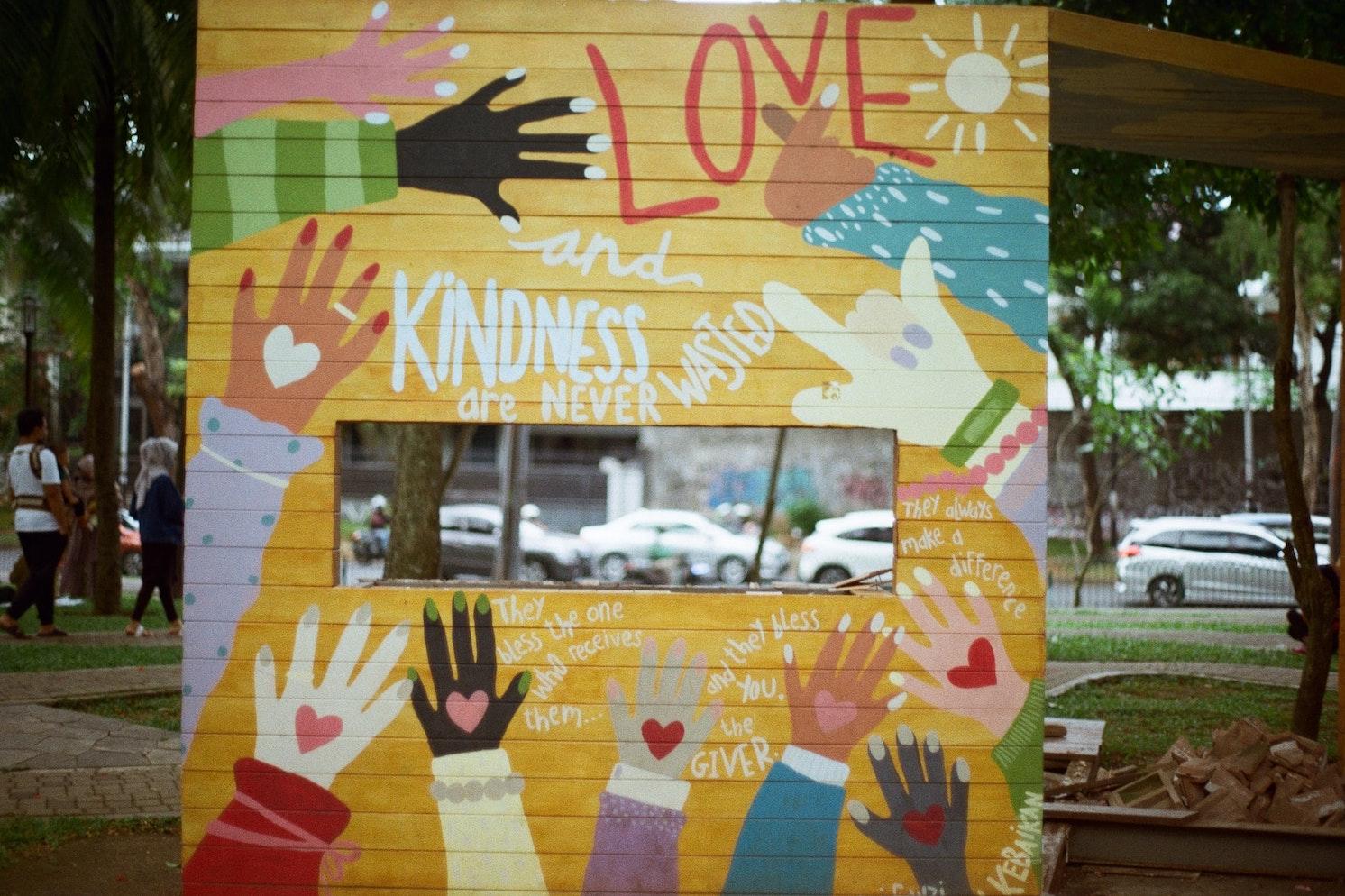
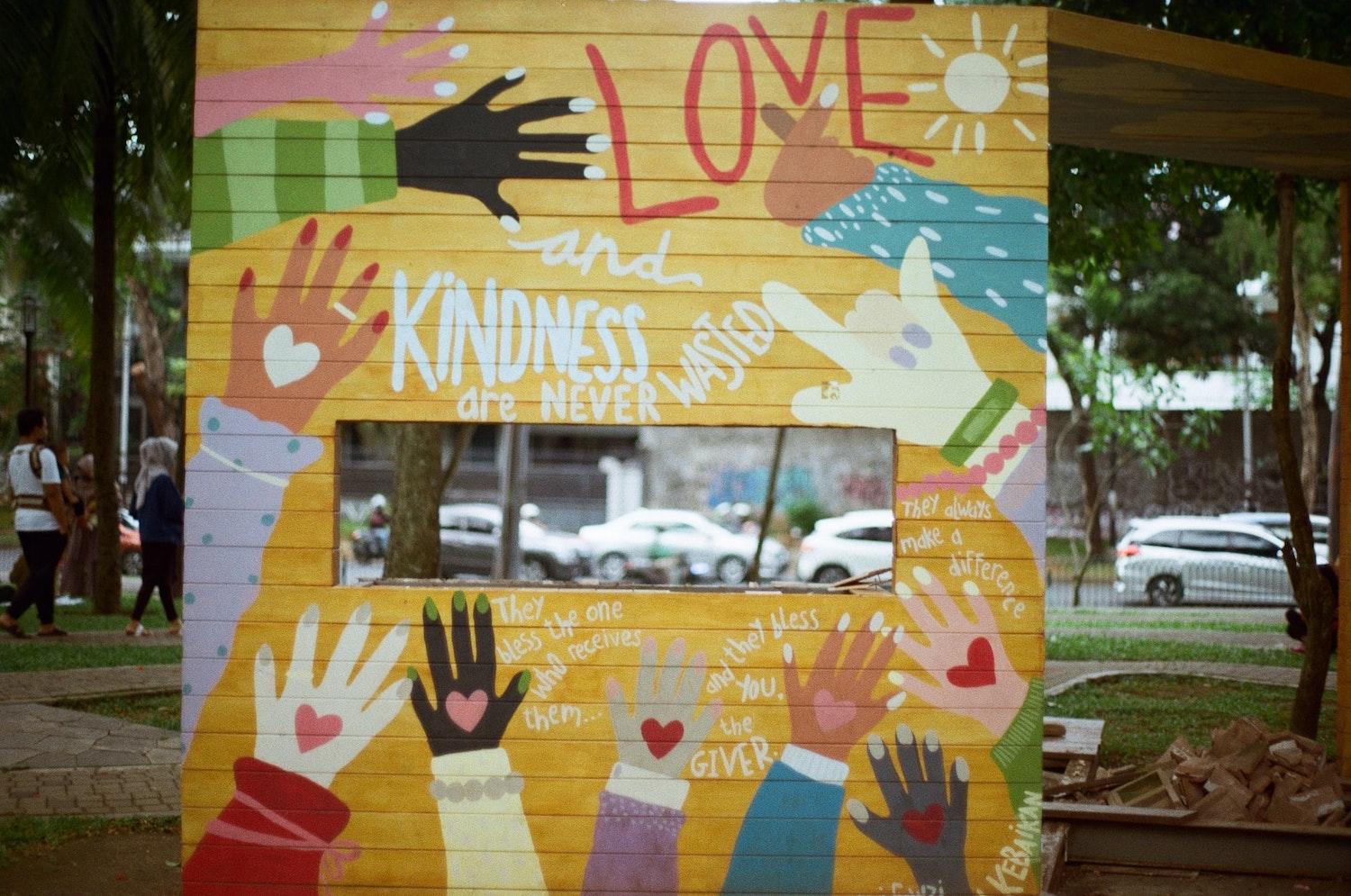
If you’re a white person who cares about the environment and you wonder why there aren’t more Black, Indigenous, or people of color (BIPOC) in your climate tech startup, environmental nonprofit or corporate sustainability program, keep reading. If you’re feeling like you’re struggling with trying to succeed in life, you want to “make a difference,” and not sure why however much money you make or whatever you accomplish doesn’t ultimately satisfy you, this is also for you.
I’ll start off by talking about some core aspects of white culture, white privilege, and how white culture impacts how we engage in communities around sustainability and the green energy transition. Examining white culture and white privilege are essential to diversity, equity and inclusion work, because work that is aimed at racial equity can ignore the background of white privilege that our society operates in. We need to take a bigger-picture view.
As Albert Einstein once said, “No problem can be solved from the same level of consciousness that created it.”
White privilege is like an “invisible knapsack”
If you identify as white, you carry white privilege everywhere you go, even if you don’t realize it. Peggy McIntosh’s essay, "Unpacking the invisible knapsack," names 50 ways that white people have privilege, such as being able to walk into a retail store and not be suspected of shoplifting, never being asked to speak for all members of their racial group, and seeing people of my race widely represented in government and on TV.
As Gita Gulati-Partee and Maggie Potapchuk outline in an article for Grantmaking in the Arts, white culture is really hard to see because it is a set of “dominant, unquestioned standards of behavior and ways of functioning embodied by the vast majority of institutions in the United States.” Just think: What does a “professional” look like? As Aysa Gray observed in the Stanford Social Innovation Review, expectations of work attire, timeliness, speech patterns and work style are a few aspects of a bias toward white culture in the workplace.
White culture is a culture of separation
More broadly, white culture is about creating separation. Separation looks like creating differences between you and me, belief in an “absolute truth” of what is “correct,” among other things. The Center for Community Organizations in Canada has outlined a summary of white supremacy culture in organizations. Have you encountered these values in your paid work or volunteering?
- Perfectionism, including worship of the written word, “one right way,” and “either/or” thinking
- Concentration of power, including power hoarding, paternalism and defensiveness
- Right to comfort, including fear of open conflict
- Individualism
- Progress is bigger/more, including objectivity, quantity over quality, and sense of urgency (the belief that “the ends justify the means”)
In this blog post, Heather Laine Talley expands on parts of white supremacy culture that she has observed in herself and others and that might be more specific to how white women bring white supremacist behaviors into the workplace, like:
- Disavowal of power
- Obsession with the future
- Performative anti-racism
- Over-delivering
- Niceness above all else
- Confusing informality with equity
Contrast the white supremacy culture of separation between self and other, human and non-human, to the Indigenous mindset of seeing nature as a family member. Robin Wall Kimmerer in her book, "Braiding Sweetgrass," discusses the “grammar of animacy.” For example, Potawatomi has a lot of verbs, whereas English has a lot of nouns. If a bay is a verb, like “to be a bay” (think San Francisco bay for example), how can you possess a process? Whereas if you see nature as an “it” (like in English), rather than a relative, it becomes easier to see how white culture makes it easier to own, dominate, subjugate, and optimize nature rather than relating to nature as a relative to care for.
Coming back to climate action: This report from Indigenous Environmental Network highlights common issues with the nature-based solutions rhetoric. One example is that the exploitative power dynamics of colonialism and economic development are entrenched in “nature-based solution” approaches to climate change mitigation. (Thanks to Ian Tran for making me aware of that article.)
White culture — a mindset of separation — reduces the amount of joy you can experience
You may be wondering: So what? Why should I care if white culture is dominant? How does white culture negatively impact my life as a white person?
As researcher Brene Brown shares in her famous TED talk with over 60 million views, we cannot selectively numb our emotions. If we use alcohol or a banana nut muffin (her example!) to numb fear or anger or other “negative” emotions, we also numb feelings of connection and joy.
If you’re a man who has ever felt stifled by having to wear a tie to work, or if you’re a woman who has been told you’re “too emotional,” those are symptoms of white culture. These are examples of white culture because they are examples of Western bias in what counts as “professional” attire and the “rational” or “objective” over the “emotional” or “subjective.”
More broadly, an obsession with the future over the present is a symptom of white culture since an obsession with accomplishing future goals can lead you to avoid being present with the joy that's available now. When was the last time you sang or danced or made art without caring what you looked like or what people thought of you? When have you last taken a vacation without checking email, or taken a week off from using a computer or smartphone?
While it’s healthy to be able to delay gratification to some degree, such as prioritizing exercise and cooking a healthy dinner over eating junk food and watching TV, focusing only on the future can lead to not celebrating what you have already. How often do you celebrate an accomplishment? How often does your organization take time to celebrate the accomplishments of its employees or volunteers? Making time for doing nothing and for celebration is one way of challenging white culture’s obsession with productivity.
What does this mean for environmental sustainability work? If we want to make meaningful change, we need to investigate the patterns that keep causing advantage to some over others, both consciously and unconsciously. We need to investigate our inner systems so we can investigate and improve our outer systems.
The psychology of self and other, ingroup and outgroup
As mammals, we see people close to us, like family, as “ingroup” members or “safe” and others or threats that might attack us as “outgroup” members. This is part of psychology called social identity theory: People tend to create and form groups of people they think are like themselves, and these can be based on any arbitrary characteristic.
Henri Tajfel and his colleagues found that people can form biases toward an in-group very quickly (in minutes!). These groups can form even based on completely arbitrary and invented discriminatory characteristics, such as preferences for certain paintings. And there is a neurological explanation for this based on activity in the fusiform gyrus area of the brain. Also, research published in the Journal of Experimental Child Psychology indicates that individuals are faster and more accurate at recognizing the faces of ingroup compared to outgroup members.
How do we unstick ourselves from a culture of separation and from the harm that white supremacy culture has caused? The next of this two-part article examines some of the inner work that can get us there — click here to read it.
Image credit: Ditto Bowo/Unsplash
Land Acknowledgment: Katharine is a Mayflower descendant who lives and works in unceded Lisjan Ohlone territory, what is now known as Oakland, Berkeley, Alameda, Piedmont, Emeryville and Albany, California. The Sogorea Te’ Land Trust is an urban Indigenous women-led land trust that is today working hard to restore traditional stewardship practices on these lands, heal from historical trauma, and facilitate the return of Indigenous land to Indigenous people. May they be successful in their work!
Check out the (re)Biz one-month program for people who want to build a regenerative world and get unstuck from separation mindsets in sustainability work — note that you get $100 off if you mention my name as the referral source.
Want a Fix for the U.S. Labor Shortage? Try Immigration Reform


U.S. Republicans conveniently pivoted away from the old “they’re taking our jobs” standby at this year’s Conservative Political Action Conference (CPAC). They’re focusing their ire on crime and drugs instead, with some participants going as far as to blame the fentanyl crisis on immigrants. Former U.S. President Donald Trump upped the ante during his address by promising mass deportations if he is re-elected.
But decades of anti-immigrant sentiment have already hurt the labor market and played a huge role in why many U.S. employers are desperate for workers. What’s worse, the current shortage of adult workers is fueling an explosion in child labor. And it’s only going to get worse if trends continue. Between falling birth rates, the baby boomer retirement cliff and the wave of immigrants returning to their home countries after decades of working in the U.S., a shrinking labor force threatens to exacerbate and even entrench the problem of child labor. Fortunately, there is a solution: robust and proactive immigration reform.
From stolen jobs to fentanyl
Anti-immigrant attitudes may be a mainstay of conservative politics, but their justifications appear to be much more flexible. Trump’s 2015 invocations of “They’re taking our jobs, they’re taking our manufacturing jobs, they’re taking our money, they’re killing us,” might ring hollow now — and maybe even prompt some to question their political loyalties in light of an actual labor shortage. But extreme conservatives have no problem pivoting to a different excuse.
The latest: fentanyl. Republicans blamed President Joe Biden’s mythical “open border” for the uptick in fentanyl deaths in the U.S. “Pick up a dollar, and it’s got fentanyl on it, and you’re dead,” Rep. Mark Green of Tennessee said at CPAC. He declared every American to be at risk.
None of this is true, of course. Fentanyl is not absorbed through the skin, nor is the majority brought into the country at unofficial crossings, as the likes of Pennsylvania Rep. Scott Perry have claimed.
The vast majority of fentanyl is actually brought into the country by U.S. citizens. In fact, 86.3 percent of those convicted of trafficking the substance are American, according to the Cato Institute. But the actual rate of smuggling by citizens could be even higher, thanks to the extra scrutiny faced by non-citizens at border crossings. After all, immigrants and asylum-seekers are much more likely to be interrogated, searched and caught, as the institute pointed out. Even under those circumstances, the drug is being seized at official border crossings or checkpoints within the border zone 9 out of 10 times.
Additionally, Trump also elaborated on his recurring claim that other countries are sending their worst. "Other countries are emptying out their prisons, insane asylums, and mental institutions and sending all of their problems right into their dumping ground,” he said at CPAC, without offering any proof to back up such claims.
Politics over solutions
Of course, the fact that conservatives are making excuses to keep people out, while ignoring the spate of labor issues that could be resolved through immigration, is hardly surprising. American politics are notorious for using the stick approach instead of the carrot, so it’s no wonder these politicians would rather address the shrinking population by eliminating a woman’s right to reproductive choice than by allowing immigrants to enter the country.
But we won’t fix the labor shortage by forcing those with uteruses to give birth while simultaneously barring would-be workers from coming across the border. Anti-immigration politics don’t just hurt immigrants and asylum-seekers — they are damaging this country as a whole by preventing necessary additions to our labor force.
The future of labor depends on immigration
The vacuum created by the shortage of adult workers has resulted in the perfect storm for child labor violations as employers attempt to fill their workforces. But it doesn’t have to be this way. By instituting a vigorous immigration program with work visas and a path to citizenship, the U.S. can reverse the population slowdown and avoid a decline that many fear would decimate the economy and cause a range of supply chain issues and unmet needs.
Another Trump presidency could pummel the labor force even further, however. "Under my leadership, we will use all necessary state, local, federal, and military resources to carry out the largest domestic deportation operation in American history,” he promised CPAC crowds. While Trump is notorious for his broken promises, his words were clearly meant to stoke the flames of hatred that are behind accusations like fentanyl trafficking and job stealing. “We will pick them up, and we will throw them out of our country, and there will be no questions asked.”
Image credit: Kerwin Elias/Unsplash
3 Meaningful Ways to Advance Gender Equity in the Workplace


International Women's Day is observed every March 8 as a celebration of women and their achievements and a call-to-action for accelerating gender equity. This year's theme, #EmbraceEquity, is meant as a call for collective action on pushing gender equity forward — and arguably nowhere is that more important than within the private sector.
Research continues to show that both women and businesses — not to mention the global economy — lose out due to gender inequalities in the workplace. The most recent evidence came this week from Moody's Analytics, which found the global economy could get a $7 trillion annual boost if there were more women in the workforce and those women had equal opportunities to advance. "In other words, closing the gender pay gap wouldn’t just benefit individual women. It would also benefit everyone," observed Stephanie Hughes of Marketplace.
But such a reality is a long way off. At this rate, it will take more than 300 years to reach global gender parity in education, employment and economic opportunity, according to the most recent data from the U.N.
So, what are some measurable steps that global businesses can take to push toward gender equity in the workplace? Let's look at a few that are backed up by research and supported by working women and advocates worldwide.
Become more transparent about pay to boost gender equity and close the pay gap
The global gender pay gap has remained virtually unchanged for the past two decades, according to the International Labor Organization. While research is mixed on why that is, one evidence-based intervention has been shown to make a major difference, and that's pay transparency.
Employers that utilize salary transparency across the organization see pay inequity drop overall — whether on the basis of age, race, gender or sexual orientation. Looking at gender equity in the U.S. in particular, employers could reduce the gender pay gap by 40 percent if they embraced broad pay transparency, according to peer-reviewed research published in 2019.
“Firms are also wary of wages getting compressed and losing their best talent to competitors without transparency,” professor Tomasz Obloj of HEC Paris Business School, who co-led the study, told Wired. “But in the data, the opposite happens — there’s no exodus of superstars from organizations that become transparent, and amid the Great Resignation, we can’t apply the lens of the ’70s and ’80s, when it was enough to offer high-powered incentives.”
Move from mentorship to sponsorship
"I’m tired of hearing the oft-repeated wisdom: 'Women need to find mentors to ensure career success,'" Ruchika Tulshyan, author of "The Diversity Advantage: Fixing Gender Inequality in The Workplace," told Diversity Woman Magazine. Women aren't lacking in professional mentors — most report having at least one mentor in their careers, with some research indicating women are even more likely to have mentors than men, Tulshyan observed.
What they really need is sponsorship, and there's a major difference. "While mentorships are often informal relationships, sponsors are advocates for a professional’s advancement within her organization," she explained. "Many strategic decisions, such as staffing an organization’s most visible projects or highest promotions, are still made informally — on golf courses or over dinner. Finding an advocate within these circles can help high-potential women and leaders of color get much-deserved access and visibility."
Indeed, research from economist and lauded inclusion expert Sylvia Ann Hewlett finds that women who receive sponsorship are 19 percent more likely to be promoted, and managers who become sponsors are more than 50 percent more likely to advance, building on prior research from the likes of Catalyst and JPMorgan Chase.
Be a family-friendly employer
Statistically speaking, women aren't paid for the majority of the work they do. Every year, the World Economic Forum analyzes the total time men and women spend on non-leisure activities each week — including hours at their paid jobs, as well as the time they spend on unpaid household activities like cleaning, shopping, bill-paying and childcare.
The latest findings are pretty disheartening: The average woman spends 45 percent of her working time doing the job she's actually paid for and the other 55 percent on childcare and other unpaid domestic work. That's compared to 81 percent of time on paid work and 19 percent of time on domestic work for men (and yes, that domestic work does include caring for their own children).
With this in mind, it's not surprising that challenges in balancing home and work life are a major reason why women drop out of the labor force or struggle to advance. Some pundits interpret this with a spin on the "no one wants to work anymore" mentality — essentially saying women find their family lives more important, and there's nothing employers can do about that.
But let's be honest: There is plenty employers can do, and there's plenty of data to back that up. For example, economies that provide public or subsidized child care have more than twice the percentage of women wage earners, according to the World Bank. While they wait (and hopefully lobby) for governments to do the right thing, the companies that step in with their own childcare policies will attract and retain more talented women, benefitting their own bottom lines as well as the economy.
Offering childcare benefits has been found to lower absenteeism by 30 percent and reduce turnover by 60 percent, while boosting recruitment and employee productivity, according to the Early Care and Learning Council. Research indicates that more parents of color are likely to leave the workforce due to childcare issues. As such, 90 percent of HR leaders said childcare benefits can help support a diverse workforce, and 86 percent said the same about senior care benefits, according to a 2022 survey of 500 human resources professionals across U.S. industries.
Likewise, while over 120 countries mandate paid parental leave, companies in laggard nations like the U.S. have the opportunity to stand out by offering these benefits even though they are not required: A 2020 survey of more than 440,000 working parents at 1,200 U.S. companies shows that generous paid parental leave and other parental benefits are linked to higher rates of retention and engagement.
The bottom line: Governments, employers and civil society all have a role to play in promoting gender equity
“Gender equality is growing more distant,” U.N. Secretary-General António Guterres said during a General Assembly speech on Monday — pointing to ongoing issues such as attacks on abortion rights in the U.S. and the resurgence of the Taliban in Afghanistan.
The widening gender gap demands collective action not only by governments, but also business and civil society leaders around the world. "It calls for gender-responsive education and skills training, algorithms that align with human rights and gender equality and investment in bridging the digital gender divide,” Guterres said. “More than ever, we need collective action by governments, civil society, the private sector and the technology community.”
Image credit: RF._.studio/Pexels
What ESG Issues Do Consumers Really Care About?


Research has more than made the case for linking environmental, social and governance (ESG) strategies to corporate profitability. What’s good for people and the planet does, indeed, benefit a company’s bottom line. The trickier part is determining what programs will yield the best results for the investment.
Some ESG pathways are easier to attain and measure direct results, such as cost reductions. But top-line market growth demands a greater understanding of customer wishes and perceptions of a company’s ESG efforts. Those expectations and priorities will differ by industry sector, as well as by geographies, cultures, and demographics like age and gender.
While studies and reports can point companies in the right direction with top-level overviews of trends and industry insights, real-time survey and data collection can dig deeper into what consumers prize in ESG efforts.
Measuring consumer ESG priorities across industries, brands and more
Glow, a research-technology business with offices in North America, Europe and Asia-Pacific, first started tracking what consumers think about ESG issues in relation to purchasing decisions over two years ago. It began with a field of approximately 40 issues that, through multiple research studies across three markets (U.S., U.K. and Australia), were then synthesized into 13 ESG drivers of consumer priorities and perceptions.
The process yielded a diagnostic tool called the Social Responsibility Score (SRS) that not only provides a number to tell a company how it is perceived in its ESG efforts, but also where it stands in its industry and against its competitors and why consumers score it that way.
For example, among food and grocery (F&G) companies in particular, three environmental drivers — reducing emissions, respecting natural resources, and protecting wildlife and ecosystems — ranked highest for importance among consumers, as shown below.

This isn’t to say social drivers like health and well-being aren’t important to F&G customers — they are. But understanding consumers’ top concerns at a given time can help companies prioritize, in terms of both programming and messaging successes. Communicating accomplishments in the areas that matter most to consumers can translate into customer loyalty as well as brand switching.
On the other hand, if a brand and its competitors are all communicating about the same things, it can be harder to stand out. In cases like these, a brand may opt to lean into an area that isn’t as much of a focus for peers and competitors. Or, if it finds it’s under-performing compared to peers on key issues that matter to consumers, it may decide to invest more in those areas and communicate an improvement story.
Listening to consumers via data capture enables this kind of decision-making, helping brands to get the most return on their ESG investments.

Take, for example, these two anonymized F&G competitors from Australia, shown above. Both brands mapped their SRS in relation to the industry benchmark (the green line). Brand A clearly outshines Brand B on virtually all of the 13 drivers. The achievement gap in the areas most important to consumers, such as “reducing emissions” is substantial enough to be a significant opportunity for Brand A to message that success to customers hungry for guidance on where to invest their purchasing power. Meanwhile, Brand B can see where it’s progressing and where further investments can help it improve credibility.
ESG drivers differ across industries
What weighs heaviest on consumers’ minds will vary across industries. For example, Glow found that governance and social drivers are the biggest influences on ESG credentials in the health insurance industry in the U.S., as shown below.

In travel and tourism, on the other hand, U.S. customers view all three divisions of environmental, social and governance factors as important for the sector to address.
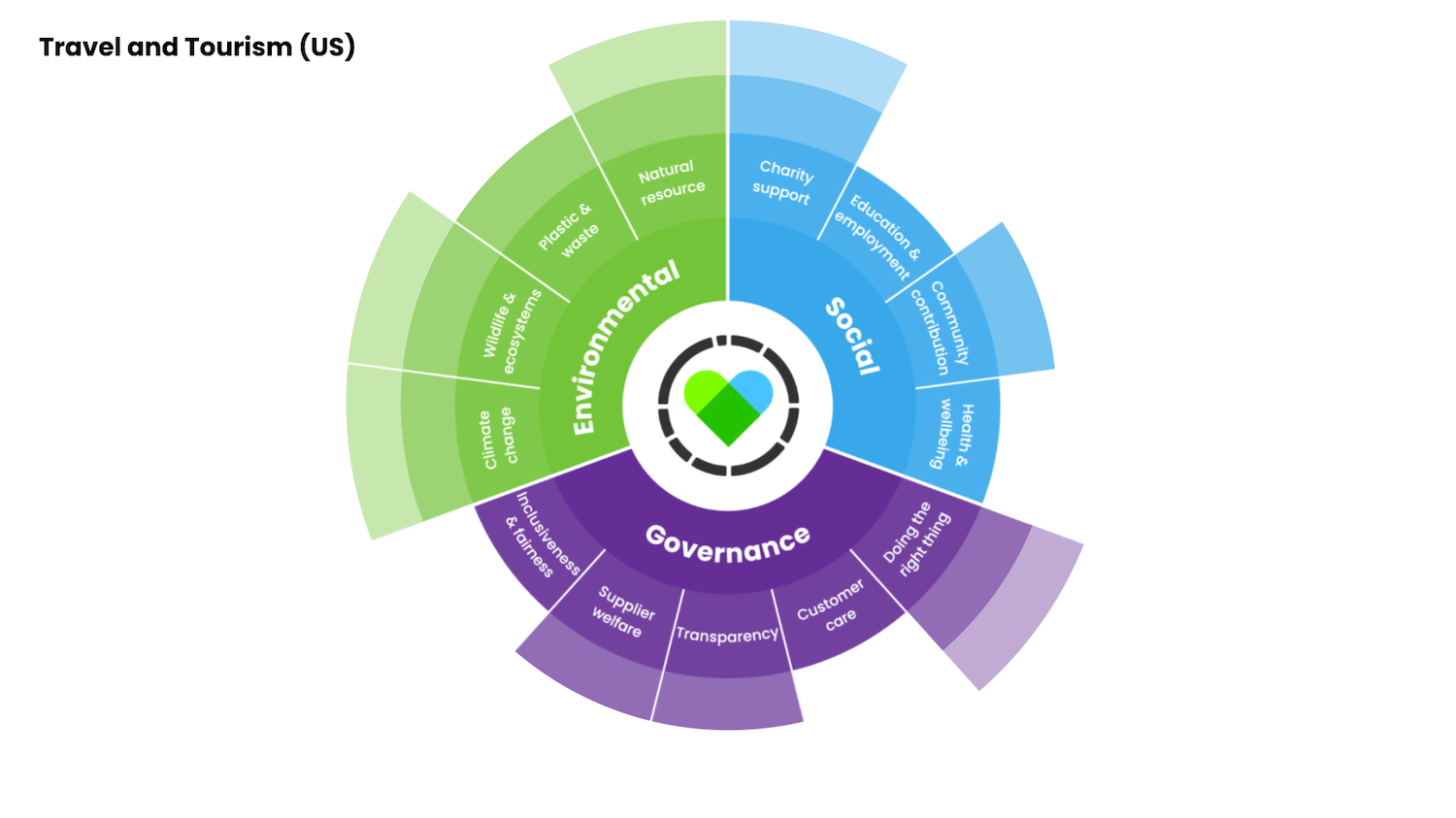
In a balanced framework such as the latter, drilling further down into age, gender, geography, and competition among brands is vital to determine the focus for programs and messaging to avoid spreading investment and resources too thin.
Continuing to zero-in on what matters to who
Price and quality are typically the engines powering consumer choices, but business leaders may be surprised at how strong “sustainability” has become as a beacon to consumers looking for safe harbor for their purchasing dollars.
This is especially true in the F&G sector — where 1 in 2 U.S. consumers have switched brands based on sustainability considerations, and 1 in 5 ranked ESG/sustainability as one of the top three drivers for deciding what brands to purchase, according to Glow data.

Diving deeper to look at age segmentation, millennials prized ESG/sustainability even higher, with 1 in 3 such consumers rating it as one of their top three considerations, behind price and quality. Further, 10 percent of millennials rated ESG/sustainability as the top influencer of their purchase decisions, even more than price and quality, Glow found.
These findings demonstrate the importance of ESG initiatives and messaging to any company’s bottom line. To fail in listening and responding to consumers in this regard is to surrender profits and reputation to competitors that are willing to leverage the feedback.
Data and surveys give a brand that feedback continuously since the measurements can be taken over set time periods, in connection with program launches or in tandem with media campaigns.
“The response from people taking these surveys is actually very clear. You can understand what it is that’s driving the consumer response and what’s driving the metric you receive,” said Tim Clover, CEO of Glow. “It allows you to line up the programs you’re running with the different areas and ask, ‘Are these the programs we should be communicating?’ If so, to whom do we communicate and through which media?”
Alignment of ESG programs with consumer expectations, coupled with alignment of messaging to bring about positive public perception of those programs, creates a winning combination for brands.
The tools exist to know what ESG concerns consumers really care about. The decision to use those tools enables business leaders to enhance brand profitability while “doing the right thing.”
This article series is sponsored by Glow and produced by the TriplePundit editorial team.
Image credits: georgerudy/Adobe Stock and Glow
Walgreens Claps Back at Medication Abortion Foes, But Not Really


Walgreens set off a media firestorm last week when the company appeared to knuckle under a Republican-led attack on its sale of the popular abortion medication mifepristone. Walgreens issued a clarification earlier this week, but it may be too little, too late. The legal status of mifepristone is under attack by anti-abortion factions affiliated with religious extremism. Walgreens and other pharmacies will be forced to take a stand on their own principles until the legal clouds part – if they ever do.
The background: The Biden administration pushes back against anti-abortion state laws and braces for an attack on mifepristone
The media storm churned up in the aftermath of a February letter penned by attorneys general from 20 Republican-controlled states — in which they warned both Walgreens Boots Alliance and CVS against selling mifepristone through the U.S. Postal Service.
The letter was intended to thwart a January finding issued by the U.S Department of Justice, which helps to protect access to medication abortion by mail. Specifically, it shields employees of the U.S. Postal Service from criminal charges related to state laws that outlaw or restrict the use of mifepristone.
As an additional protective measure, in January the U.S. Food and Drug Administration also established a new certification process that empowers pharmacies to continue selling mifepristone at their stores and through the mail.
The FDA first approved mifepristone in 2000, and some critics have charged that forcing pharmacies to undergo a new certification process is burdensome considering the drug has established a solid safety track record for more than 20 years. However, the certification process will help provide the Joe Biden administration with legal leverage to challenge a new lawsuit filed against the FDA by Alliance Defending Freedom.
ADF is the same conservative Christian group behind the successful Dobbs v. Jackson challenge to abortion rights in the U.S. Supreme Court. A decision on the FDA case is now in the hands of Matthew Kacsmaryk, a federal judge in Texas appointed by former President Donald Trump. Kacsmaryk is affiliated with a conservative Christian organization and has expressed support for restricting access to both abortion and contraception.
What’s a pharmacy to do?
The Biden administration has signaled that it will appeal if Kacsmaryk decides to strip FDA approval from mifepristone.
In the meantime, Walgreens has apparently begun taking steps to protect itself against legal action in Republican-led states. On Feb. 21, Kansas Attorney General Kris Kobach issued a press statement declaring that Walgreens has agreed “not to mail the medical abortion pill into the state,” in addition to agreeing not to dispense mifepristone at its stores in Kansas.
That press release didn’t seem to create much of a media stir, and the issue seemed to fade from sight by the end of Feburary. However, the media spotlight finally struck home last Friday when CNN reported that Walgreens “will not distribute abortion medication in 20 states, bowing to pressure from anti-abortion lawmakers and lawsuits targeting the legality of medication abortion.”
Numerous other news organizations picked up the story, including National Public Radio. On March 4, NPR reported that “Walgreens won't distribute abortion pills in states where Republican officials have threatened legal action — including some places where abortion is still legal and available.”
In the same story, NPR quotes a March 3 statement it received from Walgreens, in which the company said it is still taking steps to sell mifepristone in “jurisdictions where it is legal and operationally feasible."
Walgreens tries to clear the waters
Walgreens clarified its position in a statement posted on its website on Monday. “We want to be very clear about what our position has always been: Walgreens plans to dispense mifepristone in any jurisdiction where it is legally permissible to do so,” the statement reads. “Once we are certified by the FDA, we will dispense this medication consistent with federal and state laws.”
“Providing legally approved medications to patients is what pharmacies do, and is rooted in our commitment to the communities in which we operate,” the company added.
That position seems reasonable enough for a leading U.S. corporate citizen faced with a legal landscape fraught with landmines. But the company may have waited too long to set the record straight.
California Gov. Gavin Newsom brought further attention to the issue earlier this week. In response to the March 3 CNN report, he posted the following message on his Twitter account on Monday: “California won't be doing business with @walgreens — or any company that cowers to the extremists and puts women's lives at risk. We're done.”
As of this writing, the actual impact on Walgreens operations in California is unclear. By the time Walgreens issued its updated statement on Monday, “a spokesperson for the governor said ‘all relationships’ between Walgreens and the state were now under review but declined to detail how business ties might change,” Reuters reported.
One outcome is perfectly clear, however. The legal cloud over abortion rights is impacting the business of health care in every state, Republican or not. To the extent that business leaders have supported Republican candidates for office, they have only themselves to blame.
Providing financial bandwidth for religious extremism to insert itself into positions of powerful public responsibility was never a good idea to begin with, and the fallout is spreading with every passing election. As the 2024 presidential election cycle gears up, business leaders have an opportunity to help banish governance-by-belief and restore informed, fact-based policymaking to the legislative bodies in all 50 states.
Image credit: Stephanie Rhee and Jennifer Shishmanian via Unsplash
Your Tax Dollars at Work: 3 New Clean Power Resources to Watch
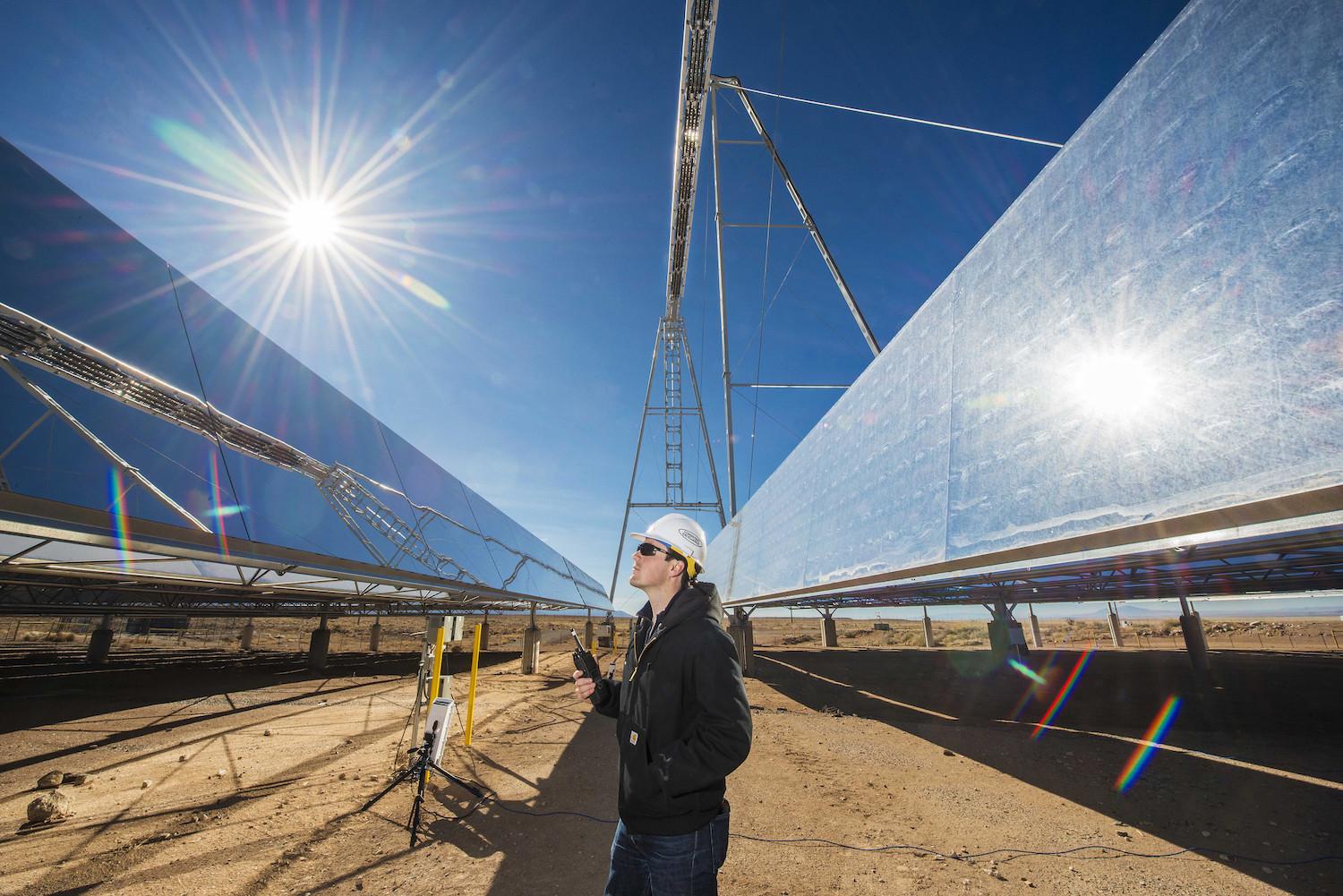
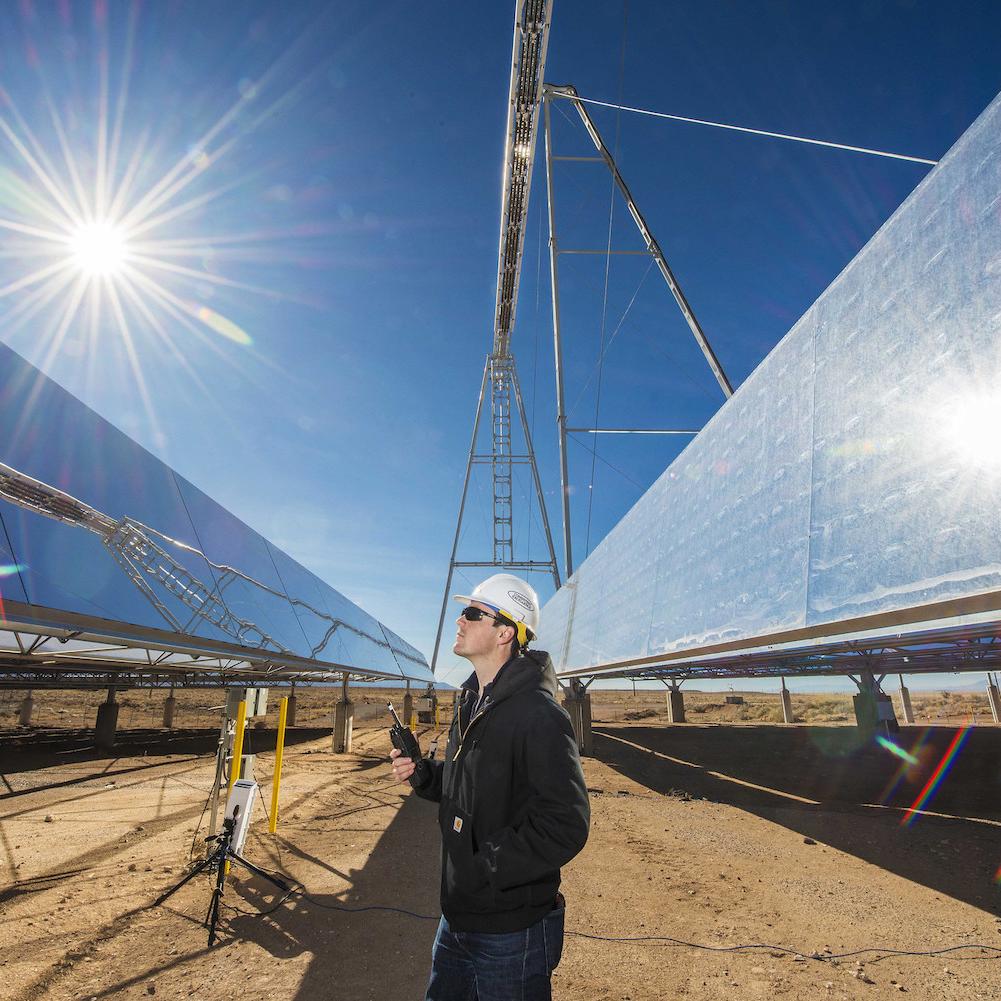
The National Solar Thermal Test Facility operated by the Energy Department’s Sandia National Laboratory in Albuquerque, New Mexico.
Wind turbines and solar panels have finally surged into the mainstream of the U.S. energy profile, but that doesn't mean the renewable energy field has fully matured. Vast new clean power resources are yet to be tapped, and the U.S. Department of Energy is leveraging its financial muscle to lift new, sustainable energy systems from the design table to commercial production.
1. Concentrating solar power plants
Concentrating solar power plants do just what the name implies. Using specialized mirrors, they pull sunlight from a range of inputs and concentrate it on a central point. The result is a powerful blast of heat that can be transferred to a liquid medium, such as molten salt or a specialized oil.
The heated medium can be used to supply clean power for industrial processes that require high temperatures. It can also be sent to a boiler room to produce steam to generate electricity.
Concentrating solar systems are large, complex and expensive compared to conventional arrays of solar panels, but they do have a key advantage. The heated medium acts as a built-in storage reservoir, enabling the solar energy to keep working long after the sun goes down.
These solar-thermal systems are gaining traction as a clean power solution in some parts of the world, but they have been slow to catch on in the U.S. The U.S. Energy Department showcased a group of five concentrating solar projects during the Barack Obama administration, but investor follow-through did not materialize after the White House changed hands.
The apparent lack of private-sector interest did not deter the Energy Department. During former President Donald Trump’s first year in office, the agency launched a $100 million research effort called Gen3 CSP — which aimed to drive down the cost of solar-plus-storage to 5 cents per kilowatt-hour, with facilities in the range of 100 megawatts capable of delivering clean power on a 24/7 basis. At that scale, concentrating solar systems would replace conventional fossil energy power plants and nuclear energy, too.
There are two key, intertwined differences between the Gen3 program and the Obama-era projects. One is the use of ceramic particles instead of molten salt. The ceramic formula can withstand higher temperatures of more than 800 degrees Celsius.
That high temperature calls the second key element into play. The range of 800 degrees Celsius enables the storage medium to power a turbine that runs on a fluid state of carbon dioxide instead of conventional steam. These “supercritical CO2” turbines are much more compact and efficient than conventional turbines, leading to the potential for reducing costs.
Gen3 passed a significant milestone last month when the Energy Department’s Sandia National Laboratory broke ground on the construction of a pilot project at the National Solar Thermal Test Facility in Albuquerque, New Mexico. Researchers in Saudi Arabia and Australia are also contributing to the pilot project, which is on track for completion in 2024.
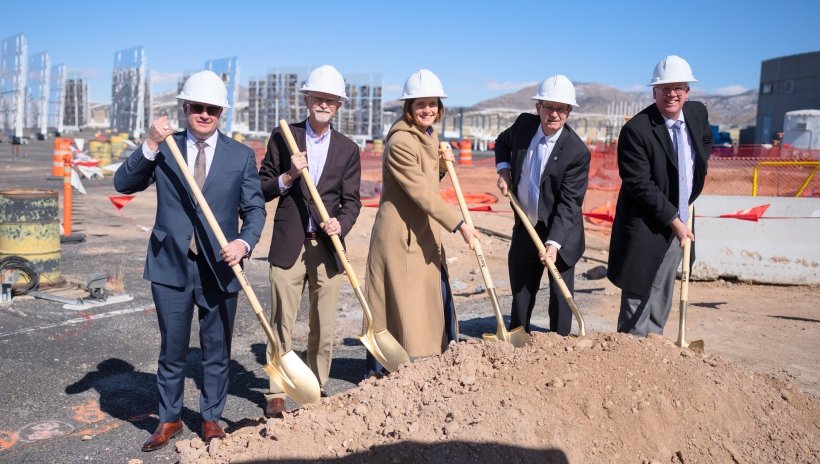
2. Electrofuels from the sea
Another emerging clean power technology to watch is the area of synthetic liquid fuels. Until recently, synthetic hydrocarbon products were made by liquifying coal, gas or other fossil energy inputs. The next generation of synthetic fuels revolves around electrofuels, which are made from captured carbon and green hydrogen.
Much of the activity in the green hydrogen field is centered on electrolysis systems that push hydrogen gas from water with electricity from wind turbines, solar panels or other renewable resources. Of particular note is the offshore wind industry, which is beginning to adopt green hydrogen systems as a complementary technology that puts wind turbines to use at night and at times when demand for electricity normally drops.
The carbon-capture field is also showing signs of moving out to sea. Conventional carbon-capture systems are designed to process ambient air or industrial gases on land. However, researchers note that seawater is already a carbon-capture medium, holding up to 150 times more carbon than air by volume.
Supported by a $650,000 grant from the Energy Department’s ARPA-E funding office, a research team from the Massachusetts Institute of Technology has proposed an offshore seawater carbon extraction system that could be used to help prevent the over-carbonization of seawater from fish farms and other aquaculture activities. The team also makes a case for attaching the system to desalination facilities, and they anticipate that cargo ships could install the system to offset their carbon emissions.
If the MIT system achieves widespread use, the researchers anticipate it would capture far more carbon than existing markets can absorb. Most of the captured carbon would have to be stored in underground formations, they presume.
However, activity in the green hydrogen field shows no signs of slowing down. That presents an opportunity to use the captured carbon for electrofuel systems, which could be located offshore as well as onshore. Recycled-carbon markets — which utilize captured carbon to create raw materials for new products — are also emerging in the plastics and synthetic fabric industries, among others.
The Energy Department seems determined to ensure the supply of captured carbon is sufficient to feed these growing markets. On Feb. 16, the agency’s ARPA-E energy innovation office announced a new $45 million funding program aimed at supporting the development of a commercial seawater carbon extraction industry.
The U.S. Navy has also been providing financial support in the seawater-to-fuel field. That includes a collaboration with the University of Rochester, the University of Pittsburgh and the company OxEon Energy. In 2020, the team demonstrated a new catalyst to convert captured carbon dioxide to carbon monoxide, a necessary step toward producing liquid fuels from gases. OxEon has also received Energy Department funding to develop its technology.
Additionally, in 2022 the Navy awarded $3 million to the University of South Carolina to work on systems for producing ammonia fuel with hydrogen extracted from seawater.
3. Enhanced geothermal systems
Geothermal resources are the sleeping giant of U.S. clean power production, limited to just a few parts of the country by suitable subsurface opportunities. The Energy Department has been working with academic researchers and industry stakeholders to develop a new approach called enhanced geothermal, which involves engineering human-made reservoirs in subsurface formations.
In February, the agency launched a new $74 million grant program for enhanced geothermal systems aimed at unlocking the potential for at least 90 gigawatts of geothermal energy by 2050 over wide areas of the U.S. In comparison, the nation’s current geothermal capacity rests at only 3.7 gigawatts.
Alongside the rapid increase in geothermal development, the Energy Department is also targeting a game-changing 90 percent drop in costs by 2035. “Investments in [enhanced geothermal systems] can unlock affordable clean energy for over 40 million American homes and exponentially increase opportunities for geothermal heating and cooling solutions nationwide,” according to the agency.
The work in geothermal comes under the DOE's “Energy Earthshots” program, the Joe Biden administration’s signature program for accelerating the clean power transition in tandem with new job creation and more equitable economic development opportunities.
Including the geothermal program, Earthshots has already launched six initiatives that pair private-sector partners with research teams and federal financial resources. The five other programs involve green hydrogen, long-duration energy storage, carbon-negative technologies, floating offshore wind turbines, and new approaches for industrial heat.
Leadership in the Republican Party may continue to rail against “woke capitalism” and advocate for a government “so small you don’t even realize it’s there,” as the Republican National Committee tweeted on March 2. However, that ship has clearly sailed. U.S. businesses and innovators are moving on to create a new energy paradigm with the collective support of U.S. taxpayers, regardless of anything that opportunistic Republican leadership can say or do.
Image credits: Sandia Labs/Flickr and U.S. Department of Energy
How to Grow a Sustainability Pilot Into Reality at Scale


Meta data centers are among the most advanced, energy-efficient in the world. Despite their enormous footprint, however, these structures are designed with the respect of our land, our communities, and our people in mind by incorporating design and construction strategies that conserve energy and water, eliminate waste, and responsibly source materials. The result: Our facilities are LEED Gold certified and supported by 100 percent renewable energy.
To drive innovation and efficiency beyond these high standards, our team has multiple pilot programs in various stages of pursuit and delivery. They vary from experimenting with low-carbon concrete and tracking the circular economy of materials, to testing the feasibility of an all-electric construction vehicle fleet and sourcing alternative fuel sources. Yet they are united by one goal: to create future data centers on the cutting edge of performance and sustainability.
A successful pilot means not only securing buy-in from internal stakeholders, along with funding and manpower, but also mapping a path to applicability and scalability across the enterprise. When it comes to determining whether a pilot is viable, our team begins with a five-factor framework:
- Impact: What is the impact of this strategy?
- Application: What is the universality of the pilot?
- Engagement: How will we communicate, with various stakeholders, a message that will most resonate?
- Prioritization: Where will this fall in the line of current and future projects/initiatives?
- Funding: What is the cost (money, time, effort, education/training) to implement?
These questions help us shape each pilot and support higher-level focuses, such as reducing Meta’s carbon footprint. When Meta’s Net Zero program was in its infancy, for example, we strategized pilots to test new technologies and approaches to track the impacts of material composition in our mechanical, electrical and plumbing equipment; our facilities’ operational waste; and potential of alternative fuel types.
In 2021, we proposed HVO (hydrogenated vegetable oil) as a carbon-saving alternative to diesel for construction equipment at one of our European facilities. The site had regional availability of the fuel type, plus the application and contractor partner were deemed a good fit. Ultimately, timing and cost made the pilot too challenging to pursue. Fortunately, our team's extensive analysis on HVO provided the solid promise for a future opportunity with a greater understanding of a successful pilot proposal and further refinement of stakeholder engagement, as well as a new Risk Registry tool to identify potential risks in a project that can derail intended outcomes.
Today, those lessons have shaped an exciting pilot to test low-carbon concrete, the primary contributor to emissions from data center construction (and 8 percent of global emissions overall). Our pilot leveraged artificial intelligence (AI) to identify and test low-carbon concrete mixes and, ultimately, resulted in use at scale in our data center in DeKalb, Illinois, in 2022. In a partnership with the University of Illinois at Urbana-Champaign, we utilized AI to find a sustainable concrete mix with 40 percent lower carbon emissions. The team worked closely with our concrete trade partner, Ozinga, on test applications in non-critical areas to meet a combined goal of both low-carbon and long-term strength requirements.
It’s true that the carbon footprint during the data center construction phase can often be overlooked. To offset this, we work with our general contractors to communicate ways to reduce (and eliminate) the barriers to going green on a typical job site. Meta’s general contractors now implement technologies and processes for more efficient builds, linking to carbon reductions with partners and circularity in our materials. At our Altoona, Iowa, site, we are upscaling onsite tracking to include both construction and operational waste (as well as using hybrid-fuel construction equipment). It’s just one combination leading our builds to greater, sustainable impact.
Thanks to our robust and vetted piloting program, along with engaged stakeholders, we are able to build with successful social and environmental impacts while providing opportunities to integrate new technologies and strategies across our portfolio. We minimize risks across our facilities by testing ideas — whether a change in design or construction, or even a process — and gain wider acceptance before rolling it out for wide-scale application.
And thus, our work toward greater performance and sustainability continues to build.
This article series is sponsored by Meta.